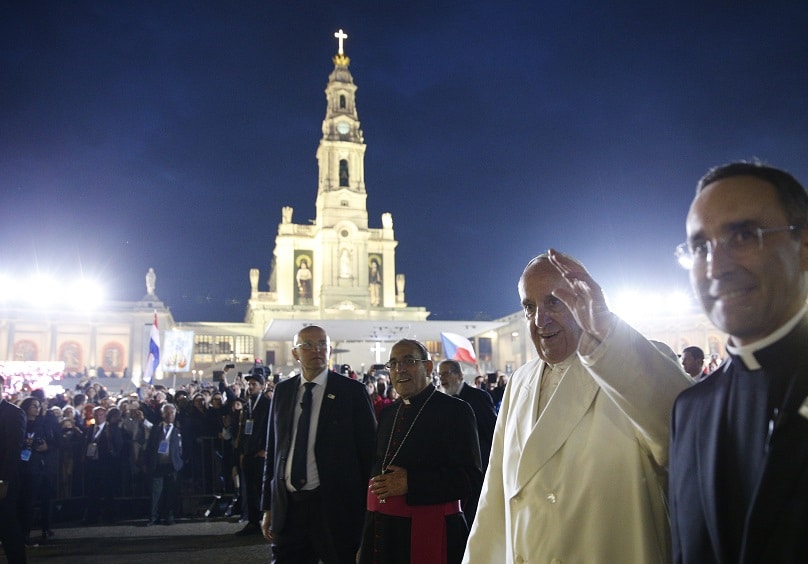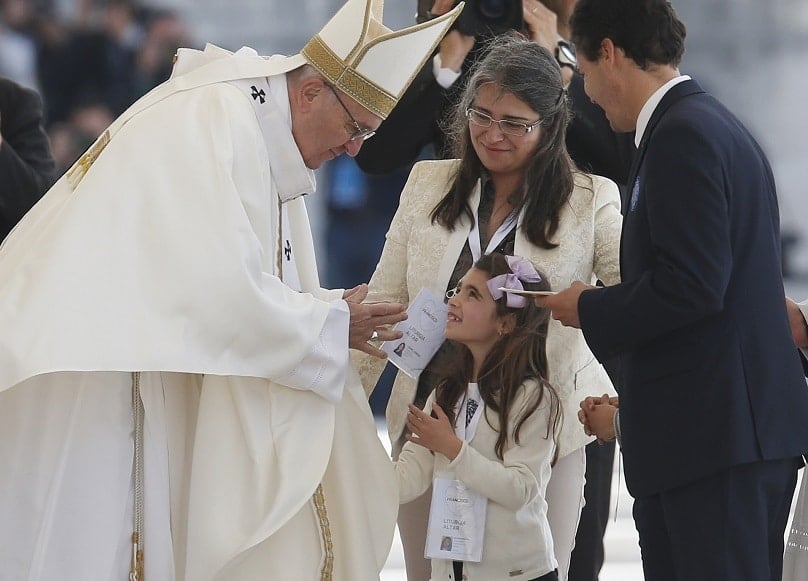
Mary’s example of believing and following Jesus is what matters most; she cannot be some image “of our own making” who Christians barter with for mercy, Pope Francis said.
On the eve of the 100th anniversary of the Marian apparitions at Fatima,
Is the Mary they honour “a woman blessed because she believed always and everywhere in God’s words or a ‘plaster statue’ from whom we beg favours at little cost?” he asked.
As the sun set at the shrine dedicated to Our Lady of Fatima, pilgrims held thousands of lit candles, filling the square with a fiery light before Pope Francis led them in praying the rosary.
The pope already had visited the shrine earlier in the evening, arriving by helicopter from Monte Real air base. Excited crowds, waving flags and white handkerchiefs, cheered as he arrived in his popemobile.
He then made his way to the Little Chapel of the Apparitions where Mary appeared to three shepherd children May 13, 1917. The apparitions continued once a month until October 13, 1917, and later were declared worthy of belief by the Catholic Church.
The festive cheering of the crowd turned to near absolute silence as the pope spent several minutes with his head bowed and hands clasped in prayer, occasionally looking up at the statue of Mary venerated by his predecessors and millions of devotees across the globe.
Pope Francis then recited a prayer he wrote, an expanded version of the traditional Salve Regina (“Hail Holy Queen”).

Alternating his verses with a choral refrain venerating the “Queen of the Rosary of Fatima,” the pope consecrated himself to Mary and entrusted to her intercession a suffering humanity where blood “is shed in the wars tearing our world apart.”
Begging Mary’s assistance, the pope prayed that believers would “tear down all walls and overcome all boundaries, going to all peripheries, there revealing God’s justice and peace.”
“In the depths of your being, in your immaculate heart, you keep the sorrows of the human family, as they mourn and weep in this valley of tears,” the pope prayed.
He also presented himself before the image of Mary as “a bishop robed in white,” a reference to the third secret revealed to the children at Fatima. Published 83 years after the Fatima apparitions, the vision described the image of a “bishop dressed in white” shot down amid the rubble of a ruined city.
The official Vatican interpretation, discussed with the visionary Sister Lucia dos Santos before its publication, was that it referred to the persecution of Christians in the 20th century and, specifically, to the 1981 assassination attempt on the life of St John Paul II.
As Blessed Paul VI and retired Pope Benedict XVI did before him, Pope Francis placed a small silver vase containing 24-karat gold roses at the foot of the statue. Embedded in the statue’s crown is one of the bullets used in the assassination attempt against St John Paul II on the feast of Our Lady of Fatima, May 13, 1981.
Returning to the little chapel for a nighttime vigil, Pope Francis reminded pilgrims to pray, as Mary taught the children at Fatima, for “those most in need” of God’s mercy.
“On each of the destitute and outcast robbed of the present, on each of the excluded and abandoned denied a future, on each of the orphans and victims of injustice refused a past, may there descend the blessing of God, incarnate in Jesus Christ,” he said.
Pope Francis held up Mary as a “model of evangelisation,” particularly because Christian men and women can look at her and see that “humility and tenderness are not virtues of the weak but of the strong.”
Those who emphasise God’s punishment of sinners, he said, commit “a great injustice” to him by not recognising that sinners “are forgiven by his mercy.”
“Mercy has to be put before judgment,” he said, “and, in any case, God’s judgment will always be rendered in the light of his mercy.”
“With Mary, may each of us become a sign and sacrament of the mercy of God, who pardons always and pardons everything,” he said.
